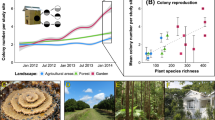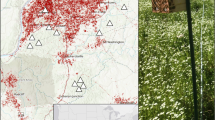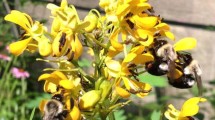Abstract
Native bee abundance has long been assumed to be limited by floral resources. This paradigm has been established in large measure because more bees are often found in areas supporting greater floral abundance. This could result from attraction to resource-rich sites as well as greater local demographic performance in sites supporting high floral abundance; however, demographic performance is usually unknown. Factors other than floral resources such as availability of nest sites, pressure from natural enemies, or whether floral resources are from a mixed native or mostly monodominant exotic assemblage might influence survival or fecundity and hence abundance. We examined how the survival and fecundity of the native solitary bee Osmia lignaria varied along a gradient in floral resource abundance. We released bees alongside a nest block at 27 grassland sites in Montana (USA) that varied in floral abundance and the extent of invasion by exotic forbs. We monitored nest construction and the fate of offspring within each nest. The number of nests established was positively related to native forb abundance and was negatively related to exotic forb species richness. Fecundity was positively related to native forb species richness; however, offspring mortality caused by the brood parasite Tricrania stansburyi was significantly greater in native-dominated sites. These results suggest that native floral resources can positively influence bee populations, but that the relationship between native floral resources and bee population performance is not straightforward. Rather, bees may face a trade-off between high offspring production and low offspring survival in native-dominated sites.


Similar content being viewed by others
References
Antonini Y, Martins RP, Rosa CA (2003) Inverse density-dependent and density-independent parasitism in a solitary ground-nesting bee in Southeast Brazil. Trop Zool 16:83–92
Bates D, Maechler M, Bolker B (2011) lme4: Linear Mixed-Effects Models Using S4 Classes. R package version 0.999375-42. http://CRAN.R-project.org/package=lme4. Accessed 17 Mar 2014
Biesmeijer JC, Roberts SPM, Reemer M, Ohlemüller R, Edwards M, Peeters T, Schaffers AP, Potts SG, Kleukers R, Thomas CD, Settele J, Kunin WE (2006) Parallel declines in pollinators and insect-pollinated plants in Britain and the Netherlands. Science 313:351–354
Bjerknes AL, Totland O, Hegland SJ, Nielsen A (2007) Do alien plant invasions really affect pollination success in native plant species? Biol Conserv 138:1–12
Bowers MA (1986) Density dynamics of bumblebees in subalpine meadows: competition and resource limitation. Holarct Ecol 9:175–184
Buchmann SL, Nabhan GP (1996) The pollination crisis—The plight of the honeybee and the decline of other pollinators imperils future harvests. Sciences (N Y Acad Sci) 36(4):22–27
Corbet SA, Bee J, Dasmahapatra K, Gale S, Gorringe E, La Ferla B, Moorhouse T, Trevail A, Van Bergen Y, Vorontsova M (2001) Native or exotic? Double or single? Evaluating plants for pollinator-friendly gardens. Ann Bot 87:219–232
Crawley M (2002) Statistical computing. An introduction to data analysis using S-Plus. Wiley, Chichester
Cresswell JE, Osborne JL, Goulson D (2000) An economic model of the limits to foraging range in central place foragers with numerical solutions for bumblebees. Ecol Entomol 25:249–255
Cripps C, Rust RW (1989) Pollen preferences of seven Osmia species (Hymenoptera: Megachilidae). Environ Entomol 18:133–138
D’Antonio CM, Vitousek PM (1992) Biological invasions by exotic grasses, the grass/fire cycle and global change. Annu Rev Ecol Syst 23:63–87
Dukas R (2005) Bumble bee predators reduce pollinator density and plant fitness. Ecology 86:1401–1406
Fultz JE (2005) Effect of shelterwood management on flower-visiting insects and their floral resources. MS thesis, Montana State University, Bozeman
Galeotti P, Inglisa M (2001) Estimating predation impact on honeybees, Aplis mellifera L. by European bee-eaters Merops apiaster L. Rev Ecol 56:373–388
Goodell K (2003) Food availability affects Osmia pumila (Hymenoptera: Megachilidae) foraging, reproduction and brood parasitism. Oecologia 134:518–527
Goulson D (2003) Effects of introduced bees on native ecosystems. Annu Rev Ecol Syst 34:1–26
Greenleaf SS, Williams NM, Winfree R, Kremen C (2007) Bee foraging ranges and their relationship to body size. Oecologia 153:589–596
Herrmann F, Westphal C, Moritz RFA, Steffan-Dewenter I (2007) Genetic diversity and mass resources promote colony size and forager densities of a social bee (Bombus pascuorum) in agricultural landscapes. Mol Ecol 16:1167–1178
Hingston AB, McQuillan PB (1998) Does the recently introduced bumblebee Bombus terrestris (Apidae) threaten Australian ecosystems? Aust J Ecol 23:539–549
Hopwood JL (2008) The contribution of roadside grassland restorations to native bee conservation. Biol Conserv 141:2632–2640
Inouye DW (1978) Resource partitioning in bumblebees—experimental studies of foraging behavior. Ecology 59:672–678
Kleijn D, van Langevelde F (2006) Interacting effects of landscape context and habitat quality on flower visiting insects in agricultural landscapes. Basic Appl Ecol 7:201–214
Klein AM, Vaissière BE, Cane JH, Steffan-Dewenter I, Cunningham SA, Kremen C, Tscharntke T (2007) Importance of pollinators in changing landscapes for world crops. Proc R Soc Lond B 274:303–313
Kraemer ME, Favi FD (2005) Flower phenology and pollen choice of Osmia lignaria (Hymenoptera: Megachilidae) in Central Virginia. Environ Entomol 34:1593–1605
Kremen C, Williams NM, Thorp RW (2002) Crop pollination from native bees at risk from agricultural intensification. Proc Natl Acad Sci USA 99:16812–16816
Linder H (1998) Morphology and the evolution of wind pollination. In: Owens SJ, Rudall PJ (eds) Reproductive biology. Royal Botanic Gardens, Kew
Liu H, Pemberton RW (2009) Solitary invasive orchid bee outperforms co-occurring native bees to promote fruit set of an invasive Solanum. Oecologia 159:515–525
Mack RN, Simberloff D, Lonsdale WM, Evans H, Clout M, Bazzaz FA (2000) Biotic invasions: causes, epidemiology, global consequences, and control. Ecol Appl 10:689–710
Michener CD (2000) The bees of the world. Johns Hopkins University Press, Baltimore
Minckley RL, Wcislo WT, Yanega D, Buchmann SL (1994) Behavior and phenology of a specialist bee (Dieunomia) and sunflower (Helianthus) pollen availability. Ecology 75:1406–1419
Morales CL, Traveset A (2009) A meta-analysis of impacts of alien vs. native plants on pollinator visitation and reproductive success of co-flowering native plants. Ecol Lett 12:716–728
Moron D, Lenda M, Skorka P, Szentgyorgyi H, Settele J, Woyciechowski M (2009) Wild pollinator communities are negatively affected by invasion of alien goldenrods in grassland landscapes. Biol Conserv 142:1322–1332
Neff JL (2008) Components of nest provisioning behavior in solitary bees (Hymenoptera : Apoidea). Apidologie 39:30–45
Palladini JM (2013). The influence of exotic plant invasion on native bee abundance and demography, and the pollination and abundance of native plants. PhD dissertation, University of Montana, Missoula
Palmer TM, Stanton ML, Young TP (2003) Competition and coexistence: exploring mechanisms that restrict and maintain diversity within mutualist guilds. Am Nat 162:S63–S79
Phillips JK, Klostermeyer EC (1978) Nesting behavior of Osmia lignaria propinqua Cresson (Hymenoptera: Megachilidae). J Kansas Entomol Soc 51:91–108
Pinheiro J, Bates D, DebRoy S, Sarkar D, R Development Core Team (2011) nlme: Linear and nonlinear mixed effects models. R package version 3.1-102
Potts SG, Willmer P (1997) Abiotic and biotic factors influencing nest-site selection by Halictus rubicundus, a ground-nesting halictine bee. Ecol Entomol 22:319–328
Potts SG, Vulliamy B, Dafni A, Ne’eman G, Willmer P (2003) Linking bees and flowers: how do floral communities structure pollinator communities? Ecology 84:2628–2642
Potts SG, Vulliamy B, Roberts S, O’Toole C, Dafni A, Ne’eman G, Wilmer P (2005) Role of nesting resources in organising diverse bee communities in a Mediterranean landscape. Ecol Entomol 30:78–85
Pyke GH (1984) Optimal Foraging Theory—a Critical-Review. Annu Rev Ecol Syst 15:523–575
R Development Core Team (2011) R: A language and environment for statistical computing. R Foundation for Statistical Computing, Vienna. ISBN 3-900051-07-0. http://R-project.org/. Accessed 17 Mar 2014
Rosenheim JA (1990) Density-dependent parasitism and the evolution of aggregated nesting in the solitary Hymenoptera. Ann Entomol Soc Am 83:277–286
Rosenheim JA (1996) An evolutionary argument for egg limitation. Evolution 50:2089–2094
Roubik DW (1978) Competitive interactions between neotropical pollinators and Africanized honey bees. Science 201:1030–1032
Roulston TH, Goodell K (2011) The role of resources and risks in regulating wild bee populations. Annu Rev Entomol 56:293–312
Rust RW (1990) Spatial and temporal heterogeneity of pollen foraging in Osmia lignaria propinqua (Hymenoptera, Megachilidae). Environ Entomol 19:332–338
Sala OE, Chapin FS III, Armesto JJ, Berlow E, Bloomfieild J (2000) Global biodiversity scenarios for the year 2100. Science 287:1770–1774
Schmid-Hempel P (1998) Parasites in social insects. Princeton University Press, Princeton
Steffan-Dewenter I, Schiele S (2008) Do resources or natural enemies drive bee population dynamics in fragmented habitats? Ecology 89:1375–1387
Steffan-Dewenter I, Tscharntke T (2000) Resource overlap and possible competition between honey bees and wild bees in central Europe. Oecologia 122:288–296
Steffan-Dewenter I, Potts SG, Packer L (2005) Pollinator diversity and crop pollination services are at risk. Trends Ecol Evol 20:651–652
Stout JC, Morales CL (2009) Ecological impacts of invasive alien species on bees. Apidologie 40:388–409
Stubblefield J, Seger J, Wenzel JW, Heisler M (1993) Temporal, spatial, sex-ratio and body-size heterogeneity of prey species taken by the beewolf Philanthus sanbornii (Hymenoptera: Sphecidae). Philos Trans R Soc Lond B 339:397–423
Tepedino V, Bradley B, Griswold T (2008) Might flowers of invasive plants increase native bee carrying capacity? Intimations from Capitol Reef National Park, Utah. Nat Areas J 28:44–50
Torchio PF, Bosch J (1992) Biology of Tricrania stansburyi, a Meloid Beetle Cleptoparasite of the Bee Osmia lignaria propinqua (Hymenoptera, Megachilidae). Ann Entomol Soc Am 85:713–721
Vandermeer JH, Goldberg DE (2003) Population ecology: first principles. Princeton University Press, Princeton
vanEngelsdorp D, Evans JD, Saegerman C, Mullin C, Haubruge E, Nguyen BK, Frazier M, Frazier J, Cox-Foster D, Chen Y, Underwood R, Tarpy DR, Pettis JS (2009) Colony collapse disorder: a descriptive study. PLoS ONE 4:e6481
Vicens N, Bosch J, Blas M (1994) Biology and population structure of Osmia tricornis Latreille (Hym., Megachilidae). J Appl Entomol 117:300–306
Vilà M, Espinar J, Hejda M, Hulme PE, Jarošík V, Maron JL, Pergle J, Schaffner U, Sun Y, Pyšek P (2011) Ecological impacts of invasive alien plants: a meta-analysis of their effects on species, communities and ecosystems. Ecol Lett 14:702–708
Wcislo WT, Cane JH (1996) Floral resource utilization by solitary bees (Hymenoptera: Apoidea) and exploitation of their stored foods by natural enemies. Annu Rev Entomol 41:257–286
Westphal C, Steffan-Dewenter I, Tscharntke T (2003) Mass flowering crops enhance pollinator densities at a landscape scale. Ecol Lett 6:961–965
Williams NM, Kremen C (2007) Resource distributions among habitats determine solitary bee offspring production in a mosaic landscape. Ecol Appl 17:910–921
Williams PH, Osborne JL (2009) Bumblebee vulnerability and conservation world-wide. Apidologie 40:367–387
Williams NM, Tepedino VJ (2003) Consistent mixing of near and distant resources in foraging bouts by the solitary mason bee Osmia lignaria. Behav Ecol 14:141–149
Williams NM, Crone EE, Roulston TH, Minckley RL, Packer L, Potts SG (2010) Ecological and life-history traits predict bee species responses to environmental disturbances. Biol Conserv 143:2280–2291
Winfree R, Aguilar R, Vazquez DP, LeBuhn G, Aizen MA (2009) A meta-analysis of bees’ response to anthropogenic disturbance. Ecology 90:2068–2076
Wuellner CT (1999) Nest site preference and success in a gregarious, ground-nesting bee Dieunomia triangulifera. Ecol Entomol 24:471–479
Zammit J, Hogendoorn K, Schwarz MP (2008) Strong constraints to independent nesting in a facultatively social bee: quantifying the effects of enemies-at-the-nest. Insectes Soc 55:74–78
Zurbuchen A, Cheesman S, Klaiber J, Müller A, Hein S, Dorn S (2010) Long foraging distances impose high costs on offspring production in solitary bees. J Anim Ecol 79:674–681
Acknowledgments
We thank A. Tracy for pollen collection and identification, and D. Venturella, L. Stoffel, M. Mullins, and S. Prado-Irwin for field and/or labortaory assistance. The manuscript was improved by comments from E. Crone. Research was supported by an EPA-STAR fellowship to J. Palladini and grants from the National Research Initiative of the USDA Cooperative State Research, Education and Extension Service (grant number 2005-35101-16040), and the National Science Foundation (DEB-0915409 to J.L.M. and Research Experience for Undergraduates Grant DBI-0755560 & 1157101).
Author information
Authors and Affiliations
Corresponding author
Additional information
Communicated by Diethart Matthies.
Electronic supplementary material
Below is the link to the electronic supplementary material.
Rights and permissions
About this article
Cite this article
Palladini, J.D., Maron, J.L. Reproduction and survival of a solitary bee along native and exotic floral resource gradients. Oecologia 176, 789–798 (2014). https://doi.org/10.1007/s00442-014-3028-1
Received:
Accepted:
Published:
Issue Date:
DOI: https://doi.org/10.1007/s00442-014-3028-1




